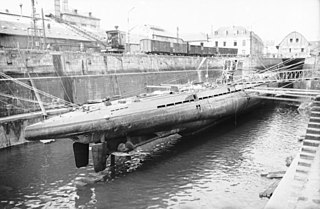German submarine U-556 was a Type VIIC U-boat of Nazi Germany's Kriegsmarine during World War II. She was laid down on 2 January 1940 at the Blohm & Voss yard in Hamburg as yard number 532, launched on 7 December 1940, and commissioned on 6 February 1941 under the command of Kapitänleutnant Herbert Wohlfarth, who commanded her for her entire career that lasted less than five months. U-556 conducted only two patrols, sinking six ships totalling 29,552 gross register tons (GRT) and damaging one other of 4,986 GRT, before she was sunk on 27 June 1941.

German submarine U-509 was a Type IXC U-boat of Nazi Germany's Kriegsmarine during World War II. The submarine was laid down on 1 November 1940 at the Deutsche Werft yard in Hamburg as yard number 305. She was launched on 19 August 1941, and commissioned on 4 November 1941 under the command of Korvettenkapitän Karl-Heinz Wolff.
German submarine U-98 was a Type VIIC U-boat of Nazi Germany's Kriegsmarine during World War II, operating from March 1941 until she was sunk in November 1942.

German submarine U-185 was a Type IXC/40 U-boat of Nazi Germany's Kriegsmarine built for service during World War II.

German submarine U-37 was a Type IXA U-boat of the German Navy (Kriegsmarine) during World War II. The submarine was laid down on 15 March 1937 at the DeSchiMAG AG Weser yard in Bremen, launched on 14 May 1938, and commissioned on 4 August 1938 under the command of Kapitänleutnant Heinrich Schuch as part of the 6th U-boat Flotilla.
Endrass was a "wolfpack" of German U-boats that operated from 12 to 17 June 1942 in attacking Convoy HG 84 that comprised 23 Allied ships. The group's name commemorated the U-boat commander Engelbert Endrass, who was killed in action in December 1941.
Blücher was a wolfpack of German U-boats that operated during the World War II Battle of the Atlantic from 14 to 28 August 1942. They attacked the Freetown, Sierra Leone to Liverpool convoys SL-118 and SL-119, and sank six ships for a total of 41,984 gross register tons (GRT), and damaged one (10,552 GRT). The group was named after Gebhard Leberecht von Blücher (1742–1819), a Prussian Generalfeldmarschall in the Napoleonic Wars.
German submarine U-70 was a Type VIIC submarine of Nazi Germany's Kriegsmarine during World War II.

German submarine U-255 was a Type VIIC U-boat that served in Nazi Germany's Kriegsmarine during World War II. The submarine was laid down on 21 December 1940 at the Bremer Vulkan yard at Bremen-Vegesack, launched on 8 October 1941 and commissioned on 29 November 1941 under the command of Kapitänleutnant Reinhart Reche.
German submarine U-438 was a Type VIIC U-boat of Nazi Germany's Kriegsmarine during World War II.
Hecht was the name of two "wolfpacks" of German U-boats that operated during World War II.

German submarine U-66 was a Type IXC U-boat of Nazi Germany's Kriegsmarine during World War II. The submarine was laid down on 20 March 1940 at the AG Weser yard at Bremen, launched on 10 October and commissioned on 2 January 1941 under the command of Kapitänleutnant Richard Zapp as part of the 2nd U-boat Flotilla.
Hai was a wolfpack of German U-boats that operated from 3 to 21 July 1942 in the Battle of the Atlantic during World War II. They attacked the Liverpool to Freetown, Sierra Leone convoy OS-33, sinking eight ships for a total of 61,125 gross register tons (GRT).
Vorwärts was a wolfpack of German U-boats that operated from 25 August to 26 September 1942, in the Battle of the Atlantic during World War II. They attacked several convoys, principally Convoy ON 127, sailing from Liverpool to New York, and sank fifteen ships for a total of 79,331 gross register tons (GRT), and damaged nine (81,141 GRT).

German submarine U-515 was a Type IXC U-boat of Nazi Germany's Kriegsmarine built for service during World War II. She was commissioned on 21 February 1942 and sunk on 9 April 1944. U-515 completed seven operational patrols and sank 23 ships, badly damaged two ships which later sank, and damaged two additional ships.
OB 293 was a North Atlantic convoy which ran during the battle of the Atlantic in World War II. It was notable for seeing the loss to the Kriegsmarine (KM) of U-47, with her commander KL Günther Prien, the person responsible for the sinking of HMS Royal Oak two years previously.

German submarine U-101 was a Type VIIB U-boat of Nazi Germany's Kriegsmarine during World War II. She had a highly successful career.
German submarine U-65 was a Type IXB U-boat of Nazi Germany's Kriegsmarine during World War II. Over the course of six war patrols between 9 April 1940 and 28 April 1941, she sank twelve ships and damaged three others for a total loss of 88,664 gross register tons (GRT).
Convoy JW 56A was an Arctic convoy sent from Great Britain by the Western Allies to aid the Soviet Union during World War II. It sailed in January 1944, reaching the Soviet northern ports at the end of the month. Twelve ships arrived safely. During the voyage JW 56A was attacked by a German U-boat force; three ships were sunk and one of the escorts damaged in the operation.
German submarine U-442 was a Type VIIC U-boat of Nazi Germany's Kriegsmarine during World War II.






